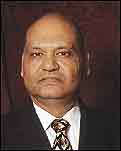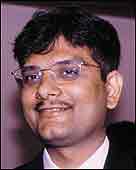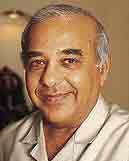|
MUNDHRA
SCANDAL: 1957
It was the media that first hinted there might be a scam involving
the sale of shares to LIC. Feroz Gandhi sourced the confidential
correspondence between the then Finance Minister T.T. Krishnamachari
and his principal finance secretary, and raised a question in Parliament
on the sale of 'fraudulent' shares to LIC by a Calcutta-based Marwari
businessman named Haridas Mundhra. The then Prime Minister, Jawaharlal
Nehru, set up a one-man commission headed by Justice M.C. Chagla
to investigate the matter when it became evident that there was
a prima facie case. Chagla concluded that Mundhra had sold fictitious
shares to LIC, thereby defrauding the insurance behemoth to the
tune of Rs 1.25 crore. Mundhra was sentenced to 22 years in prison.
The scam also forced the resignation of T.T. Krishnamachari.
 THE
SECURITIES SCAM: 1992 THE
SECURITIES SCAM: 1992
The man who seemed to own the sobriquet Big Bull, and whose
Toyota Lexus became the subject of reams of column-CMS in the media,
leveraged a loophole in the country's banking system to siphon funds
from banks (using banker's receipts) and used the money to ramp
up the prices of shares. The scam was uncovered in April 1992 and
the Sensex came crashing down from a peak of 4,467.32 on April 22
of that year to 3,896.90 on April 28. It caused ripples in Parliament,
and the quantum of money involved was placed in excess of Rs 3,000
crore, but unlike the Mundhra scam where justice was swift, the
judicial processes related to the Mehta scam continue to drag on
to this day although the man's sudden demise on December 31, 2001
(he was 47) could change that. In a bizarre twist, a few months
before Mehta's death, the CBI filed a case against him and his brother
Ashwin Mehta for allegedly selling the shares of their clients in
their possession and later claiming that these very shares were
stolen from their offices when their properties were in the court's
possession. Harshad Mehta also had another brush, albeit a minor
one, with stockmarket infamy, in 1998, but that's another story.
At the time of his death, ascribed to a cardiac arrest, Mehta had
been in jail for over 50 days over the missing-shares issue. Intriguingly,
one of the other people involved in the scam, UTI's M.J. Pherwani,
also died abruptly due to a heart attack in 1992.
 MS
SHOES SCAM: 1994 MS
SHOES SCAM: 1994
Anyone who was old enough in 1994 to read will remember the advertisements-tens
of them intriguingly headlined: 'Who is Pawan Sachdeva?' For the
record, it was the peak of the public issue-led advertising boom
and the ads were created by the Delhi branch of Rediffusion. Sachdeva,
the promoter of ms Shoes, allegedly used company funds to buy shares
(of his own company) and rig prices, prior to a public issue. He
is alleged to have colluded with officials in the the Securities
Exchange Board of India (SEBI) and SBI Caps, which lead-managed
the issue, to dupe the public into investing in his Rs 699-crore
public-cum-rights issue. Sachdeva was later acquitted.
 CRB
SCAM: 1997 CRB
SCAM: 1997
Another scam forged by greed and discovered through accident.
Chain Roop Bhansali, a smart-talking entrepreneur, created a pyramid
financial empire based on high-cost financing. At its peak, his
Rs 1,000-crore financial conglomerate had in its ranks a mutual
fund, a financial services company into fixed deposits, and a merchant
bank. That Bhansali knew how to work the system became evident when
he also managed to secure a provisional banking licence. Then his
luck ran out. An executive in the State Bank of India inadvertently
discovered that some interest warrants issued by Bhansali were not
backed by cash. The bubble finally burst in May 1997, but by that
time investors had lost over Rs 1,000 crore. This was among the
first retail scams in India and it was played out, in smaller avatars,
across the country-especially in the South where financial services
companies promised returns in excess of 20 per cent and decamped
with the principal. Bhansali was arrested for a few weeks and released
later on bail.
 MEHTA'S
SECOND COMING: 1998 MEHTA'S
SECOND COMING: 1998
The Big Bull returned to the bourses. This time, he allegedly
colluded with the promoters of BPL, Videocon International, and
Sterlite Industries to rig the share prices of these companies.
The inevitable collapse happened sooner than planned, Mehta orchestrated
a cover-up operation that included a high-jinks effort by officials
of Bombay Stock Exchange to (illegally) open the trading system
in the middle of the night to set things right, but the damage had
been done. SEBI finally passed its ruling on the scam in 2001, banning
the three companies concerned from tapping the market-BPL for four
years, Videocon for three, and Sterlite for two years. Mehta was
debarred for life from dealing in securities. SEBI's order against
Sterlite was later set aside by the Securities Appellate Tribunal
(sat) in October 2001.
VANISHING COMPANIES SCAM: 1998
A passing remark heard by then finance minister Palaniappan
Chidambaram resulted in a furore over what was a badly-kept secret
on Dalal Street. Chidambaram was told that hundreds of companies
had disappeared after raising monies from the public. An informal
scrutiny revealed that perhaps over 600 companies were missing.
Chidambaram ordered a probe by SEBI. The SEBI probe conducted in
May 1998 revealed that while many companies are not traded on the
bourses at least 80 companies that had raised Rs 330.78 crore were
simply missing. Later that year, the Department of Company Affairs
(DCA) was asked to probe and penalise these companies. DCA still
investigating. Investigations continue to this day.
 PLANTATION
COMPANIES SCAM: 1999 PLANTATION
COMPANIES SCAM: 1999
It was as innovative a swindle as any effected in the world.
Savvy entrepreneurs convinced gullible investors that given the
right irrigation and fertiliser inputs, teak, strawberries, and
anything else that could be grown, would grow anywhere in the country.
The promoters could afford to collect money from investors and not
worry about retribution (or returns, for that matter). For, plantation
companies fell under the purview of neither SEBI nor Reserve Bank
of India. Indeed, they didn't even come under the scope of the Department
of Company Affairs (DCA). By the time the government decided to
change things in 1999, enough investors had been gulled: 653 companies,
between them, had raised Rs 2,563 crore from investors. To date,
not many investors have got their principals back, just another
affirmation of the old saying about money not growing on trees.
 KETAN
PAREKH SCAM: 2001 KETAN
PAREKH SCAM: 2001
Ketan Parekh's modus operandi wasn't very different from Harshad
Mehta's. If Mehta used banker's receipts, then Parekh used pay orders
to ramp up the prices of his favourite scrips (the K-10). Apart
from money from the banking system Parekh also re-routed money from
corporates like HFCL (Rs 425 crore), and Zee (Rs 340 crore) to good
effect. He was caught when pay-orders issued by Madhavpura Mercantile
Cooperative Bank bounced. Although the total amount involved in
the scam was just Rs 137 crore, the impact was far greater.
Apparently, when a bear cartel sensed Parekh
was in trouble, it stepped in and leveraged a dip in the Nasdaq
to beat down stock prices. The resultant slump in the markets happened
soon after Finance Minister Yashwant Sinha presented what he considered
his best budget ever. Under pressure from the government, SEBI investigated
the scam and heads began to roll. Among them: the entire management
team of BSE, including its President Anand Rathi, CSFB, First Global,
and, in an indirect connection, P.S. Subramanyam, the Chairman of
UTI. Evidently, for the 18 months that PSS was Chairman of UTI,
the Trust had mirrored the actions of the bull cartel. The result?
When the market tanked, so did the NAV of its holy cow, the US-64.
-Roshni Jayakar
The Mutual Funds Boom
The history of
mutual funds in India begins in 1964; that was the year the Unit
Trust of India launched US 64. It was only in 1987 that banks and
insurance companies got into the act, with the State Bank of India
taking the initiative. Forty per cent of the funds promoted by banks
and insurance companies were launched in the go-go years between
1987 and 1993.
The first private fund, Kothari Pioneer (now
ITI Pioneer) was launched in 1993. More funds joined the party and
the total assets under management grew to Rs 61,301 crore in March
1994. But as the Sensex dropped, investor preference shifted to
fixed-income instruments in 1996. Here, most new entrants found
it difficult to compete with UTI, which had assured-return debt
products. The period 1996-98 was the worst in the history of mutual
funds. But several asset management companies used the opportunity
to restructure their portfolios, and were ready for the 1999 boom
in equities. In 1999-2000, the value of assets under management
swelled to Rs 1,07,946 crore. Then the great equity meltdown happened.
Today, there are 34 mutual fund houses managing 614 schemes and
Rs 94,571 crore in assets. Not all of them will survive, but performance
and transparency will tell in the long run.
-Roshni Jayakar
The Sensex
The New York Stock
Exchange has its Dow Jones Industrial; BSE has the Sensex. Given
the nature of the Indian stockmarket, one may be tempted to pass
this off as a portmanteau word, but the origin of the name is from
a rather staid 'sensitivity index'. The index first made its appearance
in 1986. Today, only 11 of the original club of 30 remain; the others
have been supplanted by companies whose scrips are far more indicative
of the happenings in the market. In these 15 years, BSE has launched
13 more indices, and some of these have taken some shine off the
Sensex. But the index retains its gold-standard reputation. The
highest it has ever seen: 6,150.69 (in intra-day trading) on February
14, 2000. The lowest? 956.11 on January 25, 1991, but we'd rather
not dwell on that.
-Roshni Jayakar
NSE: India's Premier Stock
exchange
 |
| The late S.S. Nadkarni: catalyst |
India's premier
stock exchange today, National Stock Exchange (NSE), was born only
as recently as November 1992. The cause of NSE was championed by
Industrial Development Bank of India (IDBI), the country's largest
financial institution, and its then chairman, S.S. Nadkarni. Other
institutions didn't like the concept of NSE; nor did brokers on
BSE who may have been averse to trading on a 'professional' exchange.
But Nadkarni, and then SEBI chairman, G.V. Ramakrishna, who had
the complete support of the finance ministry pushed it through as
the panacea to all ills that ailed the country's exchanges. Now,
a decade later, it is evident that NSE has revolutionised trading
in India. Through its network of 3,075 VSAT exchanges across 379
cities, millions of Indians, who previously couldn't, can now trade
in stocks. And competition from it has forced BSE to spruce up its
act. In October 1995, NSE became the largest exchange in India in
terms of volume of stocks transacted. In 2000-01, its total turnover
of Rs 17,70,457 crore was higher than the BSE's Rs 10,00,054.62
crore.
-Roshni Jayakar
The Great IPO Rush
Before 1977, the
stockmarket was a place for the foolhardy or the intelligent as
far as raising money was concerned. The number of initial public
offerings (IPOs) made in these years rarely crossed 20. It was the
FERA-induced dilution in the holdings of transnationals in their
Indian subsidiaries that sparked of retail interest in 1977. The
public issues of these companies were made at huge discounts as
per guidelines laid down by the Controller of Capital issues (CCI).
Reliance Industries with its 1977 IPO, subsequently expanded the
market.
The next big boom in retail came in 1984-85,
when more than 400 leasing companies entered the market. Most vanished
a year later, leading to slump in the capital market. Things revived
a bit with a couple of big branded issues like Apollo Tyre's Swarnaganga
and Reliance's Khazana in 1989. But it was the abolition of the
CCI in 1992 and the arrival of the free-pricing regime that set
off a IPO boom (the number of merchant bankers registered with SEBI
jumped to 1,163 in March 1997 before falling to 186 by March 2000).
Starting 1993, aquaculture, floriculture, granite
companies, and NBFCs made a beeline for the markets. But in March
1995, the ms Shoes scam killed the IPO market for the rest of the
decade for good, except for a short spark in 2000. Says Prithvi
Haldea, CEO, Prime Database, ''The retail investor has lost money
in the IPO market because of insufficient skills. Going ahead, we
will see increasing number of institutions in the primary market.''
-Roshni Jayakar
Doing It Online
Forget the hype,
online trading in India is yet to take off. Despite a early-2000
launch, it accounts for just 1.5 per cent of the total daily turnover
of NSE. A handful of brokerages account for the bulk of the trades:
icicidirect executes an average of 1,600 trades a day. That puts
it in the same league as the tenth-largest online brokerage in the
US.
Derivatives: A New Way
To Trade
Sebi approved derivatives
trading in June 2000. The first instruments to be traded were index
futures based on NSE's Nifty and BSE's Sensex. This was followed
by options trading on the two indices in June 2001 and options in
30 individual securities in July 2001. Futures trading in individual
stocks was permitted in November, 2001. Less than a month after
the launch, National Stock Exchange (NSE) had achieved a record
of sorts: the number of contracts (11,135 on December 14, 2001),
is the second highest in the world after Spain's MEFF and ahead
of London International Financial Futures Exchange (LIFFE).
The
Story Of The Regulator
The Securities
& Exchange Board of India (SEBI) was first set up as an administrative
entity in 1988 under the stewardship of S.A. Dave. In January 1992,
it was granted statutory powers. A decade later, though, the regulator
still seems to lack the teeth to police the markets effectively.
 |
| D.R. Mehta: seen as reactive |
|
|
| G.V. Ramakrishna: strongman |
That could well be a function of the present
Chairman, the genial and media-savvy D.R. Mehta. Under earlier chairman
G.V. Ramakrishna-the late S.S. Nadkarni, the man who held the post
between GVR and DRM, did so for all of a year-the regulator was
feared by brokers. Market buzz has it that Mehta prefers to react
to crises rather than institute a system that can prevent them.
An oft-heard refrain concerns SEBI's alacrity
in initiating 'action', and its inability to 'punish' offenders.
It took two years for SEBI to complete its investigation of Harshad
Mehta's 1998 rigging of share prices of Videocon, Sterlite, and
BPL. Mehta says SEBI doesn't have enough powers. That's a fair comment:
Justice Dhanuka report, which recommended strengthening SEBI, has
been waiting to see the light of day at the Ministry of Finance
since November 1998.
More powers apart, SEBI needs to fill its ranks
with professionals, not bureaucrats, if it wants to become independent
and market-savvy. And instead of its decisions being reviewed by
appellate tribunals, they must directly go to the high courts. Nowhere
in the world are quasi-judicial decisions by market regulators reviewed
by an arm of the executive.
-Roshni Jayakar
|

